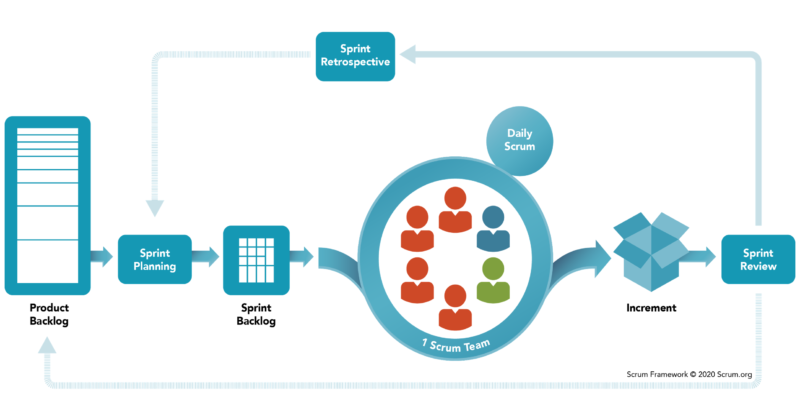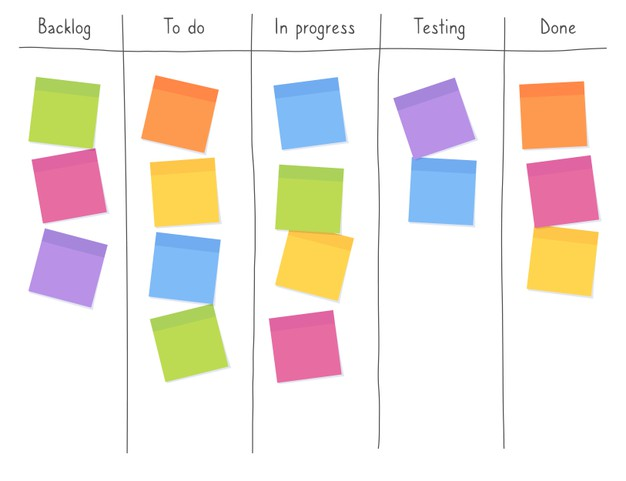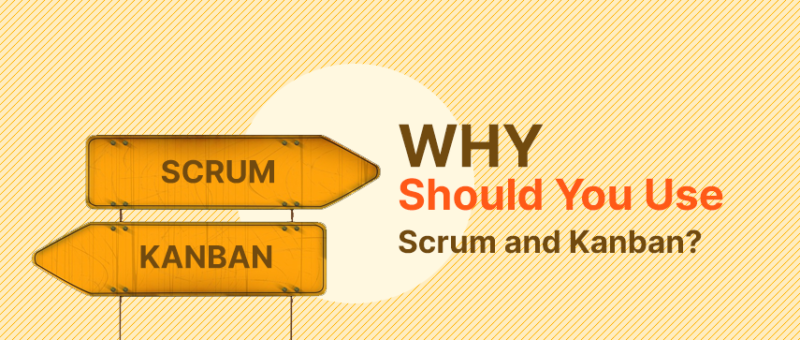
Jerry Rajamoney
He is one of the top 5 in the Agile community to have achieved the dual credential of Professional ... Read more

He is one of the top 5 in the Agile community to have achieved the dual credential of Professional ... Read more

Scrum vs. Kanban is one of the most trending comparisons in the world of agile methodology!
We often use these terms while discussing the agile way of solving problems. However, while Scrum and Kanban both have differences, their principles are the same.
Both Kanban and Scrum will help you to build high-quality products and provide better services with less hassle.
Though Scrum is one of the most popular frameworks in agile, organizations are recently started exploring Kanban. So, before discussing their differences, let us take a look at the definitions.

Scrum is an agile framework that helps organize work and deliver business value incrementally.
A team can complete these small pieces within a determined timebox (known as a sprint). In the scrum framework, everyone holds different or specific accountability.
But everyone works towards the same goal. The primary purpose of Scrum is to deliver results in the shortest timebox, emphasizing teamwork and iterative progress.
Several organizations use Scrum to deliver complex projects and products while maintaining productivity and creativity.
There are transparency, inspection, and adaption. Scrum is founded on empiricism and lean thinking. Empiricism asserts that knowledge comes from experience and making decisions based on what is observed.
Lean thinking reduces waste and focuses on the essentials.
The vital aspect of the process must be transparent to the people involved in the outcome.
Those involved in the process should also inspect the product backlog, sprint backlog, and the increment to progress toward the product goal.
Finally, teams look at the areas for improvement to do better in the next Sprint.
 Kanban is a workflow management framework that visualizes your work, improves it, and maximizes efficiency.
Kanban is a workflow management framework that visualizes your work, improves it, and maximizes efficiency.
In the Kanban framework, the work items are visually represented on a Kanban board. With Kanban boards, your team members can see the state of flow of work at any time.

From life to business, every type of work management is possible with Scrum.
According to the State of Scrum Report, 2017-2018, 97% of respondents use Scrum in their agile practice. Scrum methodology is the perfect solution if you want your team to react quickly to unforeseen changes.
Also, Scrum can manage work in a more organized way. With Scrum, your team will become more agile and efficient.
While Kanban methodology can allow small evolutionary and incremental changes to the current work process, it lets you improve the product or service delivery gradually.
You can get faster feedback to make any changes to the product or service.
So, now that you know all the basic definitions and processes of Kanban and Scrum, let's move on to our next point- the main difference between Scrum and Kanban.
| Scrum | Kanban | |
| Origin | Software Development | Lean Manufacturing |
| Ideology | Solve the complex adaptive problem | Use visual management to improve flows and processes |
| Practices | Sprint, Sprint Planning, Daily Scrum, Sprint Review, Sprint Retrospective | Visualize the flow of work Limit work in progress Manage Flow Make process policies explicit Implement feedback loop Continuous Improvement |
| Roles | Product Owner, Scrum Master, Developers | No formal role but often we have a Service Manager, Kanban Team, and Agile Coach |
| Metrics | Velocity Sprint Goal Forecasted vs Actual | Lead Time Cycle Time Throughput |
The Kanban Process: Usually, the Kanban has six main principles or work processes. These are:
The Scrum Process: In the Scrum framework, the team members work in sprints to track their work progress.
That helps them to decide what's going wrong and what's working.
Excellent communication is one of the key elements for completing sprints successfully. Usually, the scrum process includes:

We can describe Kanban as a continuous workflow structure. This workflow allows your team members to adapt to changing priorities.
You can represent work items on cards and organize them on a Kanban board.
In this Kanban board, your work items flow from one stage to another. For example, different workflow stages like to-do, in-review, done, etc.
With Kanban, you can make custom columns for your team. A content-delivering company will custom their columns as outline ready, written, proofread, and delivered.
It will help the company understand how much content they'll provide each week and their bottlenecks.
On the other hand, Scrum has a small time frame, and it moves fast. Mostly Scrum has one to four weeks of sprints and clear starting and finishing dates.
Scrum has a short time frame, which helps you to break complex tasks into smaller stories. With Scrum, your team can learn complex tasks quickly and efficiently.
Kanban: There is no product owner or scrum master in Kanban. Your entire work team will own the Kanban board.
Though you may include an agile coach in your team, there is no need to have any Kanban master. It will be entirely your team's responsibility to deliver the task on the board.
Scrum: Unlike Kanban, Scrum has three different roles- product owner, scrum master, and developer. The product owner manages the customers' feedback and product backlog.
The scrum master facilitates the scrum adoption and encourages the team to follow the scrum principles effectively.
Lastly, the scrum developers work together to meet a sprint goal, deliver increments, and work collaboratively throughout the Sprint.
In Kanban, Key Performance Indicators (KPIs) are essential for assessing and improving workflow efficiency, productivity, and quality.
By monitoring specific metrics, teams can gain insights into their performance, identify areas for improvement, and optimize their processes.
Here are some critical KPIs to consider when implementing Kanban.
Lead time: The lead time defines the time between the arrival of a new task and its departure. It begins when you or your team start working on a new task.
Cycle time: cycle time is defined as when somebody starts working on the in-progress stage. Throughput is the number of jobs finished per time unit.
Throughput: On the contrary, In Kanban, your goal is to reduce the lead time and cycle time and keep the work process efficient over time.
To keep track of lead and cycle time, you can use two charts: CFD, cumulative flow diagrams, and cycle time histograms.
In Scrum, Key Performance Indicators (KPIs) play a vital role in assessing the health and effectiveness of the project.
By tracking specific metrics, teams can identify areas for improvement, measure progress, and ensure alignment with project goals.
Here are some essential KPIs to consider when using Scrum.
Velocity: Velocity refers to the amount of work a team can manage during a sprint, which is useful in forecasting future sprints. Capacity measures the scrum team's availability for the Sprint.
Sprint Burndown: Sprint Burndown charts track the remaining work throughout the sprint. They visually represent the team's progress toward completing the sprint backlog.
By comparing planned work with actual progress, teams can identify potential bottlenecks and take corrective actions to stay on track.
Sprint Goal Success Rate: The Sprint Goal Success Rate measures the percentage of sprints in which the team successfully achieves its sprint goals.
This KPI reflects the team's ability to deliver value and meet commitments within the specified time frame.
Consistently high sprint goal success rates indicate a well-performing team and effective sprint planning.
Sprint Retrospective Action Items Completed: During the sprint retrospective, teams identify action items for improvement.
Tracking the completion of these action items over time helps assess the team's ability to implement positive changes and address issues identified during retrospectives.
It fosters a culture of continuous improvement and ensures that feedback from retrospectives is acted upon.
Customer Satisfaction: Customer satisfaction is a crucial KPI that measures the satisfaction level of stakeholders and end-users with the delivered product increments.
Feedback from stakeholders and users provides valuable insights into the product's quality, usability, and alignment with their needs.
High customer satisfaction indicates the successful delivery of value and validates the effectiveness of the Scrum process.
One size doesn't fit all! Both Kanban and Scrum are powerful processes that can efficiently manage your project and product management.
That's why it's important to explore both of them and understand their concept clearly.
If it works for you, you can use the hybrid model to taste the best of both Kanban and Scrum.
Modern businesses let teams choose the best agile feature according to their project requirements.
So, you can pick Scrum, Kanban, or a mix of both, knowing that these agile methods can evolve to meet your team's needs effectively.
No, Kanban typically does not have sprints. Kanban is a framework for managing work characterized by visualizing the workflow, limiting work in progress (WIP), and optimizing flow. It emphasizes continuous delivery and doesn't prescribe fixed timeboxed iterations like sprints in Scrum.
He is one of the top 5 in the Agile community to have achieved the dual credential of Professional Coach (PCC) & Certified Enterprise Coach (CEC). A software technologist and an SME in Agile Software Development with 20+ years of experience, Jerry is passionate about building hyper-productive teams which help organizations in their quest for Agility and Digital Transformation in today’s VUCA world.
WhatsApp Us
I have completed my training from Preeth Pandalay on 14-15 June. Training was very much to the point . He is a very good...

I attended a 4-day PMP certification classes through Agilemania. I enjoyed the teaching of Mr. Satyajit Gantayat. He has...

I recently attended a Scrum Master training workshop conducted by Satyajit, and it was one of the most engaging and info...

Amazing team under the leadership of Sumeet Madam, who is exceptionally well in teaching topics like Scrum, etc

Interactive session and a great learning with Satyajit Gantayat. Must sign up for the course if you are a beginner or wa...

We will get back to you soon!
For a detailed enquiry, please write to us at connect@agilemania.com
We will get back to you soon!
For a detailed enquiry, please write to us at connect@agilemania.com


